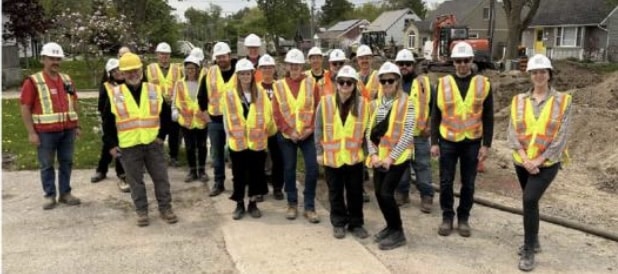Special to Barrie Construction News
The Barrie Construction Association’s Women in Construction 2025 bursary program has awarded three bursaries to female students entering the industry through post-secondary, continuing education or apprenticeships related to the skilled trades.
“It was pretty cool this year with recipients all going into different trades; one in carpentry, one going into welding and one going into plumbing,” said Michelle Dada, a consulting engineer and 2025 voluntary co-chair of the WiC group along with senior structural engineer Madeleine Smith.
The group helps fill a gap in resources for women employed in Simcoe County’s industrial, commercial, and institutional construction sectors.
It organizes and encourages professional networking and social events with women working in construction, hosts educational seminars, training and workshops with a female focus and presents guest speakers.
The group also helps raise the profile of the BCA, a 350-member organization that is advocating for measures to speed up home construction in Ontario such as a reduction in permit application approval times, said executive director Alison Smith.
Ultimately, the WiC group aims to promote education and encourage women to pursue careers in a construction industry where they continue to be underrepresented, although more women have risen to leadership positions.
“It’s nice to find groups where you can get together and dive into areas that maybe aren’t of so much interest to the guys, to be focused on our commonalities,” Dada told Ontario Construction News.
“We find a way to celebrate our differences and what we bring to the construction industry. We build each other up and appreciate everyone around us because in construction there are so many different roles. Construction takes a village.”
The group, formed in 2019 and with 15 members, has awarded annual bursaries for the past five years to women pursuing careers in the skilled trades in central Ontario’s Simcoe County. “It can make a big difference for people,” Dada said.
Awarded on June 25, this year’s recipients were down from four in 2024 — when nearly $10,000 was paid out — due to a slowdown in the construction industry, but she said the bursary remains a highlight for the Women in Construction group.
The bursary program is part of a push to increase the representation of women and young people in the construction industry—an effort considered crucial to meeting the projected demand for approximately 100,000 skilled construction tradespeople in Ontario over the next decade.
According to Statistics Canada data, women make up about 12 per cent of the construction workforce and are increasingly active in off-site positions including management, administration, and sales at around 40 per cent.
But with the female presence on-site remaining low at three to four per cent, a campaign has been ramped up to attract and retain more women at construction workplaces.
Recent initiatives aim to address gender stereotypes and promote inclusivity through measures including the provision of dedicated washrooms on larger construction sites, improved safety, and better access to childcare. A key focus is on bolstering training for women and other underrepresented groups.
Against this backdrop the province in 2023 said it would invest $3.6 million in three new programs aimed at training women and young people for construction trades through targeted and free courses, mentorship opportunities, and greater access to online resources.
Dada said while men may be more suited to some roles on a construction site, investments aimed at drawing women to the trades could in time translate into more women on the job.
“The men are doing the heavy lifting on site and I’m grateful for that but it’s good to see more women coming up through the actual trades,” Dada said.
“I’d like to follow in ten years to see if all the women going through high school majors, doing trade school and going through apprenticeships,” which are seeing a big jump in female registration, “are still in the field and if they are transitioning into project management roles.”
And while the number of women on site is still low, Dada said the stigma around working construction has eased noticeably, with the industry far more welcoming to women than when she started in the business 20 years ago.
“It’s a good time to be a woman in construction.
“It’s not so rough, people are respectful. They listen to you. It has come a long way. I feel the culture is much better. Attitudes are much better. Harassment is not happening. The boy’s club is changing.”
She also said a greater emphasis on teaching practical skills will encourage women, who may find they like to be outdoors working with their hands rather than sitting in an office all day.
Dada, who visits construction sites regularly as part of her consulting work, said she always looks forward to the experience.
“I love being on site.”

